| 1 | Bolivian anaconda |
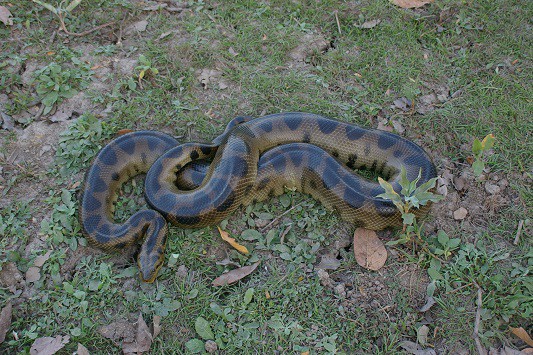
This less famous anaconda species inhabits its namesake Bolivia as well as extreme southwest Brazil. It lurks in shallow waterways and wetlands, gliding through water effortlessly while continuously scanning its surroundings with a keen serpent eye. The Bolivian anaconda lacks venom, but has an extremely thuggish hunting method. They lunge at prey with all the force of their 4 metre body, then coil around them before they can possibly recover.
A strike from this snake completely knocks the breath out of its prey. They burst forward with the power of a swinging anvil, or a barrel thrown by Donkey Kong. Disturbingly, the Bolivian anaconda doesn’t have to coil before producing this powerful strike. Other snakes need to get in position, but the Bolivian anaconda just bursts forward out of nowhere. Its muscular structure has evolved specially for sudden pounces, to support its ambush lifestyle, keeping its movements quiet until the last millisecond.
The Bolivian anaconda’s diet is wide ranging, particularly favouring mammals, but also each other. The best hope of their prey is to dart free before the flying snake hits them, otherwise their chances drop off a cliff.
| 2 | Red sand boa |
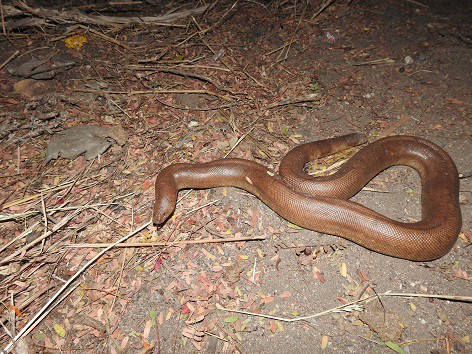
A cunning, crushing snake, with a very different personality to the humble grass snake. Eryx johnii lives in semi deserts of India and Pakistan, including dry scrubland, always with loose soils which it can burrow into easily. Their food supply includes mice and rats, which they pounce on from a position of disguise below ground. In the meantime, this is a patient snake which settles snugly into its nest within soil and waits for hours.
The red sand boa tends to have a dreamy expression the majority of the time. Not only are they immobile, but their mind seems to be in a completely different place, perhaps a slithering pit in Egypt which it wishes it lived in. They don’t look capable of much action, but the reality is that their lunge is extremely powerful. They can switch from day dreaming to pouncing in half a second.
The result depends on your species. If you’re a human, you won’t be crushed, but you might have a heart attack as a snake crashes savagely into your legs from nowhere. If you’re a rat, this may be the hour of your doom. Keeping calm is the secret to surviving this snake.
| 3 | Indian python |
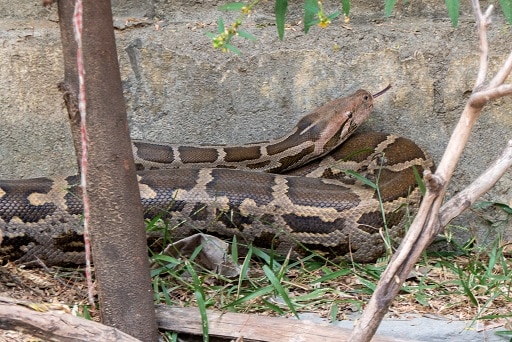
The Indian python is a thick snake measuring 4 metres, and its lunge is just as powerful as you’d expect. It’s a common constrictor found all over the Indian nation, appearing in fields, woods and along river shores alike. This flexibility has made them a great success, but so has their explosive pounce.
Indian pythons can take down wild pigs and young deer, using the sheer force of their body, before they’ve even thought of applying a coil. The power comes partly from their massive size, but also the inherent pouncing skills they possess, fuelled purely by instinct. Despite their huge size, deer still fail to spot them in the bushes, and this is when they seize their chance. They can also pounce from lakes, as this horrific video shows (warning: nightmare fuel).
A human’s muscles are designed for endless tasks: running, carrying, grappling, punching. In the Indian python, they’re geared mainly towards constriction, and performing sudden brutal lunges. Every sinew, every fiber, every cell of muscle is geared towards making this lunge overwhelmingly powerful, like a battering ram. The Indian python split off from cobras 100 million years ago, and decided not to evolve venom. Instead, they’ve been moulded and shaped ever further into a forceful body slammer.
| 4 | Fer-de-lance |
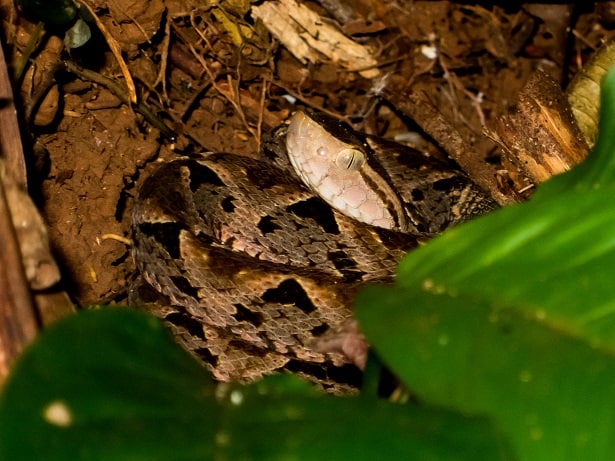
One of Costa Rica’s most feared venomous snakes. The fer-de-lance is closely related to the feared common lancehead, but inhabits Central America rather than South America.
Unlike a constantly moving cobra, the fer-de-lance is an ambushing venomous snake similar to the death adder. They like shock and awe tactics, and a thuggish sledgehammer slam is part of it. With the rodent knocked off their feet, they can inject venom and finish them off. The fer-de-lance’s favourite prey include agoutis and big-eared climbing rats, but they don’t mind springing onto human intruders either, including villagers foraging for edible plants.
The mamushi of Japan is so nifty that some villagers don’t realise they’ve been bitten. The fer-de-lance, meanwhile, has no chance of going unnoticed, due to its bulk and power. You’ll feel it slam against your shin first, then the sharp pain of a bite, unless you’re wearing leather boots. The powerful thud might give you the milliseconds you need to scrabble away, avoiding the grisly fate of cytotoxic venom and necrosis. To enable its crushing lunge, Bothrops asper likes to lurk in dry thickets, particularly on the borders of forests. These blend perfectly with their brown and beige scales.
| 5 | Madagascan ground boa |
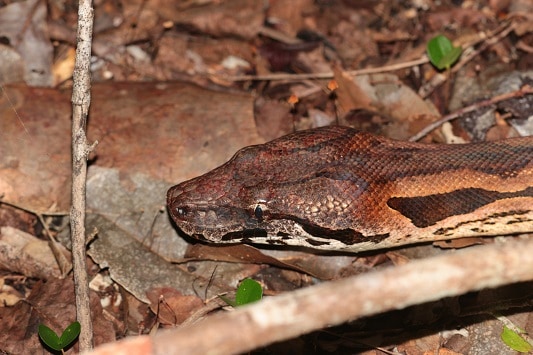
The Madagascan ground boa is a mostly calm snake which normally makes its home at the base of a thick tree trunk. They reside in dry woodlands, sometimes close to villages. Those who meet them will probably be greeted by a silent glare, but the overconfident few who get too close will be treated to an explosive lunge. The Madagascar ground boa is an ambush hunter which pounces on brown lemurs and sifakas as they pass, knocking them down and giving them no time to react. They also swallow birds in captivity, and have been recorded to reach 320cm. Forget a battering ram – this snake could probably break through a castle’s doors if soldiers placed it on the ground and begged it to do their bidding.
The Madagascar ground boa can lunge again almost immediately after the first attempt. They don’t require a coiling up phase, and they don’t need to pant and catch their breath.
Of course, there are some limits. They can pounce again extremely rapidly, but not continuously so that they’re hopping after you like a demented bunny rabbit. Likewise, they pounce rapidly, but their slithering speed is slow. You only have to back off 10 metres to watch this morbidly thuggish snake from a safety distance. That said, be careful in the Madagascan undergrowth.
| 6 | African rock python |
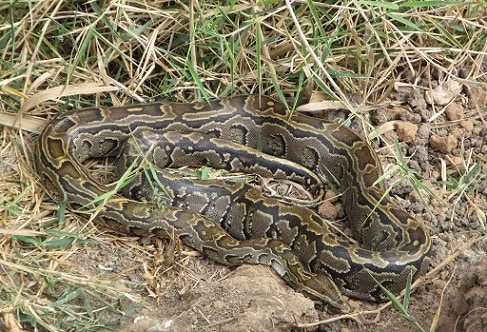
If the African rock python concentrated hard enough, it could probably spring forward and break through a front door. A flimsy back garden fence would stand no chance. In an unsteady mixture of soil and leaves, it could probably knock a human being off their feet flat onto their back, if they hadn’t noticed the snake. This might not be deadly, but would still put a dampener on your Sunday morning walk.
African rock pythons are not particularly aggressive, but can be set off like a hidden mine if you stray too close to them. They can swallow a small deer in minutes, and move little per day for several days, before revving up occasionally to seek out more bountiful feeding sites.
This 5 metre species patrols the woodlands and grasslands of sub-Saharan Africa, sometimes near farmland. The rock python’s general hunting tactics are nothing unusual. They’re an ambush snake which lurks in thickets, waiting patiently for their prey to pass. Their diet is a mixture of mammals (occasionally including hyenas) and reptiles. Yet nature blessed Python sebae both with exceptional length, and exceptional weight. While shorter than the reticulated python, the world’s longest snake, African rock pythons are typically thicker.
| 7 | Timber rattlesnake |
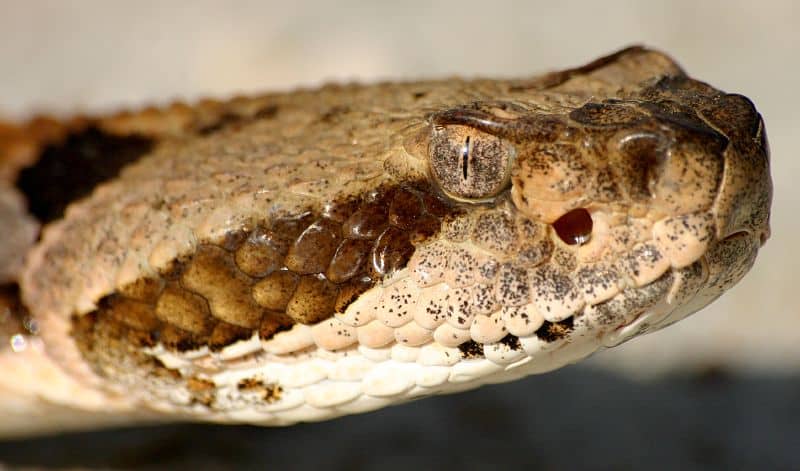
Timber rattlesnakes live in forests of the eastern USA, and are a thick-boded snake. This species averages at 90-115cm in length and 1.3-2 pounds in weight. What the timber rattlesnake lacks in elegance, it makes up for in power. They have an extremely powerful pounce, easily beating the likes of eastern racers for brute strength. They can pounce without warning, although if they could speak, they probably wouldn’t give you one anyway.
Timber rattlesnakes are quite nervous for an ambush snake and dislike humans straying too close. They live in various habitats, but particularly forests with an abundance of fallen branches and logs. Their realms include Florida, Georgia, Alabama and South Carolina.
Encountering this snake would be like a horror film. You’d walk into a small forest clearing, covered with golden leaves and a few rotting logs. All seems calm. Suddenly, a snarling rattlesnake bursts out of a leaf pile and strikes your leg within milliseconds. With the timber rattlesnake, you wouldn’t even have time to hear the leaves rustle. Fortunately, this is a non-venomous snake, and their venom isn’t especially strong – many of their precious snake power points are allocated towards a crushing jump.
| 8 | Death adder |
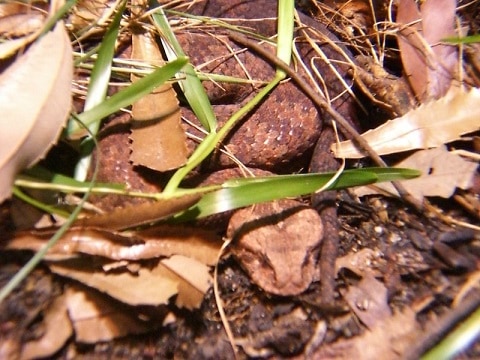
The adder is a grey and black species which is native to Australia. Its primary prey is rodents, which it tackles with a brutally powerful lunge. This snake stays immobile for weeks on end, being an ultra patient ambush hunter. In fact, a sudden brutal lunge which advances them 1 metre might be the most they’ve moved for days.
The death adder is so propulsive while pouncing that it can lift half of its body off the ground. Thinner snakes like the green tree snake would just bounce off you harmlessly, light as a feather, but the death adder collides with a nasty thud. The worst case is that they try to bite, and their fangs snag on your trouser leg. You’d have to dance around the forest trying desperately to shake an angry snake off your leg.
Being so bulky also means that they don’t aim as accurately. They don’t have to focus and carefully lock onto their target. Instead, they can just explode towards things. Death adders are mostly calm around humans, however, generally staying still unless accidentally stepped on or maybe foolishly poked with a stick.
| 9 | Palestinian viper |
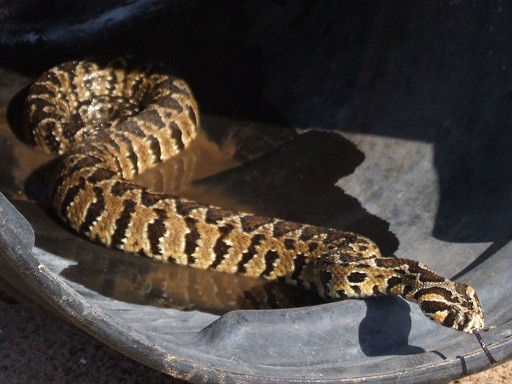
An Israeli relative of the Russell’s viper, which causes so much chaos in India. This species is shorter yet retains the same ambush strategies, complete with brutal pounce. This species bursts through the air like a coiled spring, in a sudden release of force. The Palestinian viper also attacks many humans, with strongly haemorrhagic venom. It lives in arid semi-deserts, and its one redeeming feature is sub-par camouflage, with dark stripes which make it stand out.
The Palestinian viper has a pounce like an erupting volcano. They can knock over small animals with ease, and a human is a slight possibility, if combined with the shock of a snake launching at you. They pounce from a nearly flat position on the ground, shifting ever so slightly before they explode forward. The Palestinian viper can burst from a variety of locations: shrub, behind rocks, dry bushes, swaying grass, even a cupboard door if a villager was keeping one illegally.
With its thin, nimble body, the average cobra can coil up and deliver a succession of jabbing bites, returning quickly to its original position. Palestinian vipers are less nimble, but more powerful, favouring one massive lunge like a battering ram. Instead of agility, it chose the brute force route.
| 10 | Cox’s watersnake |
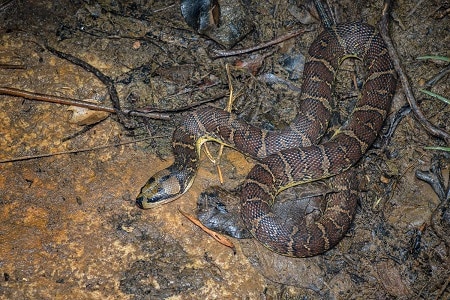
Cox’s watersnake lurks in the swamps of Cambodia and eastern Thailand, and has brown and muddy grey colours optimised for camouflage. They lurk for long periods, with only rustling trees and faint droplets of water to keep them company. Then they activate in an insane explosion of speed, aggression and force.
While only reaching 123cm, this is an ambush predator whose every sinew of muscle is optimised for taking down prey in one sudden lunge. Cox’s watersnake dislikes deep rivers, preferring shallow water bodies like streams, wetlands and swamps. They have a typical life for an ambush predator, waiting patiently in the shallows until they pick up subtle alterations in water currents generated by approaching fish. They wait until the optimal millisecond, and lunge with expert timing, seizing the fish in their jaws. Their only threat is being scooped up in fishing nets.
Cox’s watersnakes eat mostly fish, occasionally amphibians, and have a specially adapted jaw, for a grip which they never relinquish. This is a close relative of the puff-faced watersnake, which lives in southern Thailand, while Cox’s watersnake sticks to the east (plus Cambodia).
